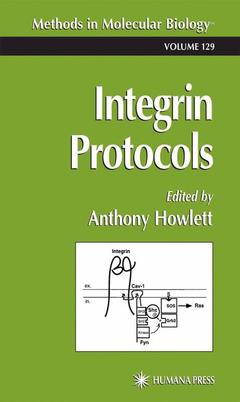Integrin Protocols, Softcover reprint of the original 1st ed. 1999 Methods in Molecular Biology Series, Vol. 129
Langue : Anglais

It is now widely accepted that the extracellular matrix (ECM) is a key determinant of tissue-specific gene expression. Signals provided by ECM are transduced by integrins, a large and growing superfamily of transmembrane heterodimeric cell surface receptors that link the ECM to structural and fu- tional elements within the cell. A wide range of cellular phenotypes have been shown to be regulated by integrins, including growth, differentiation, mig- tion, invasion, angiogenesis, and apoptosis. Furthermore, abnormalities of integrin expression and function have been implicated in the etiology of va- ous pathologic conditions, including cardiovascular disease, inflammatory disorders, and cancer. Thus integrins have emerged as an important class of molecules with wide ranging implications for understanding basic biological processes. In Integrin Protocols we provide a wide-ranging collection of laboratory protocols intended to assist investigators interested in integrins in working productively with these molecules, in studying their expression, and in pot- tially manipulating that expression to define their role(s) in relevant biolo- cal models. Protocols are provided for the analysis of integrin expression both at the RNA and protein levels (Chaps. 2, 5, and 7). Delcommenne and Streuli describe procedures for making rat monoclonal antibodies specific for mouse integrins, Schneller et al. and Arap and Huang describe methods for western blotting of integrins and RT-PCR analysis. Protocols are included that cover the analysis of the functional properties of integrins (Chaps. 1, 3, 4, 8, and 9 through 11). Koivunen et al.
Working with Integrins.- Integrin-Binding Peptides Derived from Phage Display Libraries.- Production of Rat Monoclonal Antibodies Specific for Mouse Integrins.- Biochemical Analysis of Integrin-Mediated Shc Signaling.- Assays for Kinase Activity.- Immunoblotting of Integrins.- Application of Flow Cytometry in the Analysis and Sterile Sorting of Cell Populations Based on Integrin Expression.- Expression of Integrin Transcripts in Human Cancer Cells.- Functional Analysis of Integrins.- Functional Analysis of the ?2 Integrins.- Expression of Heterologous Integrin Genes.- Preparing a Polyclonal Antibody to Mouse ?1 Integrin with Function-Blocking Activity.- Integrin Gene Targeting.- Determination of Positive and Negative Regulatory Elements.- Integrin Function at the Cellular Level.- A Cell-Based Adhesion Assay for the Characterization of Integrin ?v?3 Antagonists.- Integrins in Cell Migration.- Models for Studying Cellular Invasion of Basement Membranes.- Methods for Studying Anoikis.- Use of the 10-Day-Old Chick Embryo Model for Studying Angiogenesis.- Cell Shape and Integrin Signaling Regulate the Differentiation State of Mammary Epithelial Cells.
Includes supplementary material: sn.pub/extras
Ouvrage de 296 p.
15.2x22.9 cm
Thème d’Integrin Protocols :
© 2024 LAVOISIER S.A.S.



